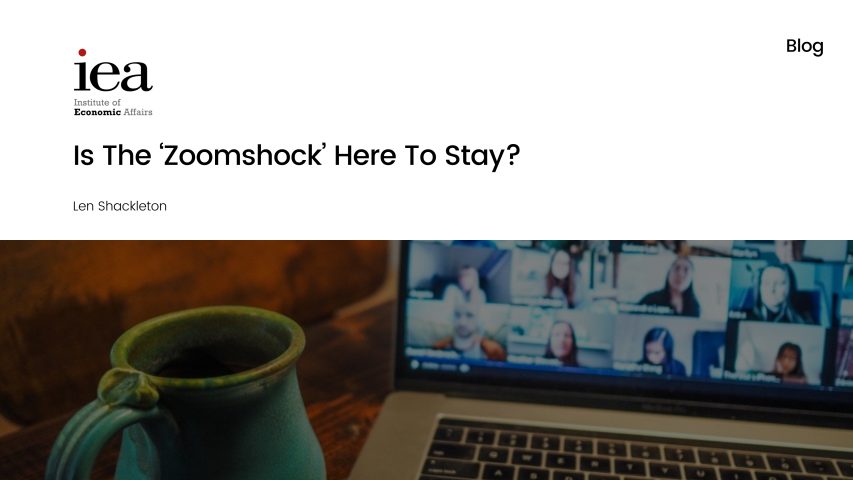Is the ‘zoomshock’ Here to Stay?

Is the ‘zoomshock’ Here to Stay?
Len Shackleton // 21 May 2021
Working at home is something many of us have got used to – maybe too used to – over the last year. In a strange way we are recreating the experience of our ancestors. For most of human history home working was the norm – whether peasants working on family farms, mediaeval craftsmen and women with family and apprentices around them, or eighteenth-century textile workers under the ‘putting-out system’, where merchants brought round wool and other raw materials which young and old family members would work up into finished cloth.
Remnants of these lifestyles survive even today. But the nineteenth century saw a shift of manufacturing into factories, while the twentieth century saw the consolidation of this process plus the development of large-scale office-based employment in both the public and private sectors.
In this century, most people worked outside the home for most of the time before the pandemic. According to the British Office of National Statistics data only around 13% of those in employment worked ‘from home’ on a regular basis before lockdowns began. But even this exaggerates the scale of home working, as 8% of these ‘home workers’ were people such as self-employed painters and decorators, electricians, plumbers, hairdressers, tutors and consultants who may have had a filing cabinet upstairs, but spent most of their working hours outside the home. Another 1% worked in buildings or grounds connected to but distinct from the home – farmers, nature wardens, resident pub landlords, shopkeepers living above the shop. Considerably less than 5% were spending their days on screens in home offices.
All this changed when we were ordered to work at home if at all possible; millions got used to a new mode of working. For lucky people, this meant turning a spare bedroom into a fully-functioning office. For others, particularly young flat-sharers, this meant the less attractive options of hogging the kitchen table or balancing a laptop on your knee in your bedroom.
Much has been made of these changes, particularly by journalists and media commentators who cannot get out as much as they used to. But not everybody has been working at home. In early March this year, around 40% of those currently working were working ‘from’ – remember that qualification – home. And remember too that about 15% of those nominally in employment were furloughed. So overall probably only about a third of workers at most were hammering away on laptops or attending Zoom meetings.
And proportions differed considerably across the working population. Home working levels in London were over twice those in Scotland, and nearly twice those in the East of England. Those aged 30-49 were far more likely to be working at home than 16–29-year-olds, many of whom were furloughed from retail, restaurant and hotel jobs. Around 80% of those working in manufacturing, healthcare, construction, energy and water supply were continuing to work every day outside the home at their normal place of employment.
So the scale of increased home working may be exaggerated. Nevertheless, for many of us it has been a revelation that so much of what we used to go into the office for can be done in a reasonably satisfactory way at home.
Many people are enjoying the experience, saving money and seeing more of their immediate family – and do not want to go back to long and expensive commutes. Recent surveys by academics, consultancies and the Bank of England suggest that a majority of respondents want a more flexible pattern of work in the future, perhaps attending offices two or three days a week while working at home for the rest of the time. Some employers seem to support this idea, thinking particularly of cost savings from cutting back on office space.
But we should be cautious in going overboard for home working. Although surveys suggest that many individual employees think they have been more productive at home than in the office, this is not necessarily borne out by others’ perceptions. Many of us have found it very difficult to contact businesses and government bodies during lockdown, and have experienced delays in getting responses on important matters. And employers have reported difficulties in recruitment processes, team-building, innovating and motivating workers. The government’s Business Insights and Conditions Survey reported in February that only 9% of businesses thought productivity had increased, while 33% thought that it had decreased. Of course there were variations from industry to industry, but in only one industry – unsurprisingly, Information and Communication – did more businesses think productivity had increased than that it had decreased.
Should home working continue at higher levels post-pandemic, there will be wider changes in the economy. Some are pretty certain: for example, having fewer commuters will damage the finances of Transport for London and whatever rail companies replace the closed franchises. Others are perhaps less obvious: Centre for Economic Policy researchers have coined the word ‘Zoomshock’ to draw attention to some of the wider effects on our big cities of more people working at home. They point to the considerable amounts of ‘locally consumed services’ (LCS) on which office workers spend – coffee shops, restaurants, after-work drinks and meals, retail outlets, gyms, theatres and so on. If half of commuters work at home two days a week, this alone means a 20% fall in potential demand for LCS, with knock-on effects on employment.
It is also likely that in the medium-term reductions in commuting will lead to people moving home. If you are not going to commute as often, you may want to move further away from the centre, where house prices are lower and you can afford to buy more space for your home office. Over time house prices outside major population centres may rise relative to those in London or Manchester.
Past experience suggests that people aged over thirty, especially those with families, are more likely than others to move further out – with white British people more likely to relocate than most ethnic minorities. Over a decade or so this will tend to make the population of London and other cities younger and with larger concentrations of ethnic minorities and immigrants and fewer middle-aged white people. This will have implications for public services, rates and council tax – and the accompanying politics.
Patterns of pay may also change. If people further out from from big cities can now work largely at home, they can compete with those closer in. This may tend to increase relative pay in some outlying areas. Conversely, this increase in competition may lead to a fall in relative pay of those closer to traditional centres of employment.
Young people, especially those from already disadvantaged minorities concentrated in cities, may find it increasingly difficult to find jobs at all as many low-paid service jobs – for example those in retailing, where there has been a huge increase in internet sales – will disappear along with the commuters.
All predictions are speculative, but if we do decide to stay working at home in the larger numbers many are expecting, there will certainly be consequences which we need to start to think through.
The articles was originally published on the IEA blog.
EPICENTER publications and contributions from our member think tanks are designed to promote the discussion of economic issues and the role of markets in solving economic and social problems. As with all EPICENTER publications, the views expressed here are those of the author and not EPICENTER or its member think tanks (which have no corporate view).



